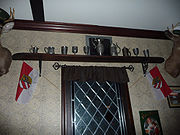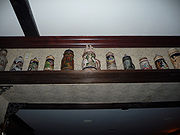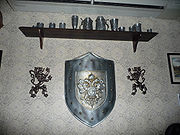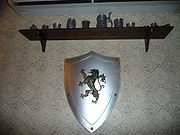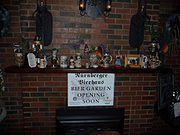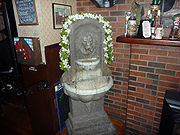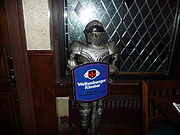From The Peopling of New York City
Nürnberger Bierhaus
Contents |
Visiting a German Restaurant
Within Staten Island, there are two German American institutions that could be found with the resources at hand (including the use of internet search engines, the website http://www.germanyinnyc.org/, and by speaking to German-American people); both of them were privately owned restaurants, namely Killmeyer's Old Bavarian Inn and the Nurnberger Bierhaus (German for Beer House). We chose to visit the Nurnberger Bierhaus primarily because of its convenient location and the positive feedback we had heard about the food, in addition to its apparent adherence to German culture, and the fact that we knew for a fact the owner was a German expatriate. One of the staff members knew one of our classmates personally.
The Nurnberger Bierhaus is located in the Castleton area of Staten Island (area code 10310). According to our research, based on the most recent census data (2000), Castleton has a slightly above average density of German-Americans (7.4% of all people enumerated were German-American compared to the average 6.425% per zip code). It directly boarders four other areas of Staten Island, these being the New Brighton/Grymes Hill area (zip code 10301, German-American population density of 6.5%), the Castleton Corners/New Springfield area (zip code 10314, German-American population density of 6.2%), Port Richmond (zip code 10302, German-American population density of 5.7%), and New Brighton is the same, virtually, as the average, New Springfield was within .2 percent, and Port Richmond is less than one percent bellow average.
While this is not the highest density of German-Americans on Staten Island, it is significant, and as stated before the region that the Nurnberger lies in does have an above average density. This probably contributes to its chosen location and its high number of German patrons, as owner Robert Kelly reports that while he has a diverse group of patrons, a significant number are of German decent. Interestingly, he has also stated that a number of European patrons, especially Eastern European patrons (he mentioned patrons who descended from Poland and the former Czechoslovakia, amongst other nations) frequently eat at the Nurnberger. This may indicate that these cultures share similarities to German culture, or it may be that they simply like the food. One cannot tell by simple observation the identity or descent of the patrons, so this information was helpful. The first time we visited, during their lunch service, people of all ages, including children, were present. When we visited the restaurant during the evening hours there were mostly adults present, but this was likely due to the time. Obviously, areas such as the restaurant area, where people of all ages are permitted, had more diversity than areas such as the bar, where the staff enforces the state law and only adults are present. This is an instance of conforming to American legal codes and norms.
Interesting Syncretisms
The menu of the restaurant is, according to Mr. Kelly, made up of entirely authentic German food, with no modifications of the cuisine made to appeal to traditional American foods. Mr. Kelly is very proud of its authenticity. The menu is also written in German, though it is adapted for American patrons by means of English descriptions. One of the meals was “Hahnchenschnitzel”, a chicken dish topped with “zigeuner” (gypsy) sauce. Michael DiBenedetto was the only one brave enough to try this sauce, and he found it delicious. In this way, we participated in the culture.
Mr. Kelly described to us how the food of the restaurant followed Bavarian influences, as Nuremberg is in Bavaria. He directed us to the restaurant’s website, which provided information on Bavarian and other German cuisine. In Bavaria, Swabia, and other southern German regions, the food is largely influenced by southern neighbors such as Switzerland and Austria. The most popular meat in German cuisine is pork, and this is reflected on the dinner menu which has an entire section complete with 8 items, dedicated to pork. Beef is another common meat, with a six item section. Veal is also served. Chicken is the most common poultry dish in Germany, and one of the only poultry choices on the menu. Sausage is also a very important part of German cuisine, and can be seen on the menu as well, with 7 items. The beer list contains several laagers, as is common in Bavaria. An adaptation to American culture can be seen as three beers listed under a section called “American Bottle Beer.” These beers are Budweiser, Michelob Ultra, and Coors Lite. Alas, we were unable to participate in this element of the culture.
The Menu
Lunch Menu: http://www.nurnbergerbierhaus.com/menuLunch.htm
Dinner menu: http://www.nurnbergerbierhaus.com/menu1.htm
Dessert Menu: http://www.nurnbergerbierhaus.com/menuDessert.htm
Beer Menu: http://www.nurnbergerbierhaus.com/beerDrink.htm
The Decor
The institution is set up as a typical eating establishment, with a separate bar and dining area, and a soon to be added outdoor dining area. It is extremely accessible to both German-Americans and people of all ethnicities; we were both very comfortable as Greek and Italian Americans in the restaurant, and enjoyed the warm and inviting atmosphere. The owner is clearly proud of his German heritage. Several staff members we spoke to were German, though non-Germans were employed, and some of them spoke German as their primary language, but were fluent in English (a necessary adaption). The owner, Mr. Robert Kelly, was also German, and he spoke to us of his city of origin, Nuremberg (Nurnberg in German), where he had lived until he moved to the United States at age 11. As such, one concrete item we noticed was a display of flags bearing the crest of the city of Nuremberg, the logo of the restaurant also carries this crest. This shows the importance that the owner places on his heritage and that city. Mr. Kelly also spoke of his mother, who was from Nuremberg as well, and how she is part of his motivation for keeping the restaurant authentic.
There were many other decorations throughout the restaurant that were all from Germany. Mr. Kelly proudly displayed large numbers of silverware from Germany, many of which were his mother’s. He also had many German Beer Steins. Beer Steins are a type of German stoneware mug, often sold as collectibles or as decorative items. The Steins were beautifully decorated with artwork on them, and displayed on shelves close to the ceiling. Also displayed were two great Elk heads and German shields. There were also figurines, all from Germany, displayed on shelves and on a fireplace mantle, as well as photographs of the staff and restaurant. In addition to the decorations, German music was being played throughout the restaurant. However, one adaptation in the décor to American culture was a large television displayed facing the bar displaying American sports news. There was one suit of armor we noticed as we left (which one of our number almost knocked over), that had what we assumed to be a German beer company’s logo painted on its shield. We suspect this was not an actual suit of armor, as only some sort of three foot tall creature could have fit in it.
Mr. Kelly proudly displayed large numbers of silverware from Germany, many of which were his mother’s. He also had many German Beer Steins. Beer Steins are a type of German stoneware mug, often sold as collectibles or as decorative items. The Steins were beautifully decorated with artwork on them, and displayed on shelves close to the ceiling. Also displayed were two great Elk heads and German shields. There were also figurines, all from Germany, displayed on shelves and on a fireplace mantle, as well as photographs of the staff and restaurant. In addition to the decorations, German music was being played. However, one adaptation in the décor to American culture was a large television displayed facing the bar displaying American sports news. There was one suit of armor we noticed as we left (which one of our number almost knocked over), that had what we assumed to be German beer company’s logo painted on its shield. We suspect this was not an actual suit of armor, as only some sort of three foot tall creature could have fit in it, but we are uncertain, more information would be needed to make a definite determination.
